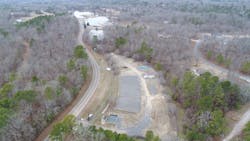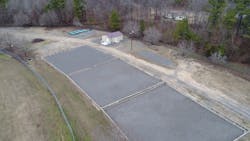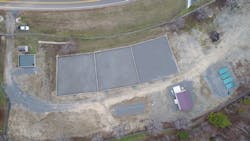Riviera Utilities
Cost: $624,056
Location: Hot Springs, Ark.
Year: 2018-12-01
Size: 50,000 gpd
Owner: PMI
Designers: Brad Wingfield, P.E.
Contractor: Environmental Process Systems
Riviera Utilities’ primary goal with its project was to design a cost-effective and reliable treatment system to replace the intermittent sand filter being used to treat wastewater from the Diamondhead community near Hot Springs, Ark. The 50,000-gal-per-day (gpd) facility has experienced long-term problems meeting effluent limits for pH, carbonaceous biochemical oxygen demand, and ammonia. The new treatment system needed to produce much more consistent results.
“[The primary goal was to] achieve compliance 100% of the time within the given budget,” said Andy Davis of New Water Systems.
The company wanted to save as much money as possible on capital expenses while avoiding the long-term operation and maintenance costs of sludge handling and disposal.
The primary treatment method prior to the project had been intermittent sand filters followed by disinfection.
The utility had received an engineering proposal for a sequencing batch reactor (SBR) treatment facility at an estimated cost of more than $2 million. If it had pursued this option, it would have obligated itself to the capital cost of a mechanical plant featuring suspended-growth, activated-sludge treatment, including the long-term operation and maintenance cost of sludge handling and disposal.
The company instead contacted PMI, an engineering services firm. PMI recommended a two-stage treatment process: recirculating media filters (RMFs) followed by Orenco AdvanTex AX100 wastewater treatment systems. This would cost one-third as much as the SBR proposal and would reduce the long-term costs of operation and maintenance.
The design used recent design guidance, case study data and PMI’s experience with decentralized wastewater treatment. It incorporated much of the existing infrastructure, which lowered the overall project cost.
RMFs are proven technology, although they are not currently in wide use. The key to their success involved finding media that met specifications regarding size and uniformity. If the media was too large, hydraulic capacity would increase but treatment capacity would decrease. If the media was too small, the opposite would happen. Fortunately, PMI found a washed, crushed rock that was locally available. During construction, samples were taken at intervals to ensure the proper material was being used.
Pressurized distribution laterals were installed to distribute primary treated wastewater over the filter bed. The laterals are fed by a buried 30,000-gal fiberglass recirculation tank with pumps controlled by a timer. To contain solids, the primary tank was converted into a primary clarifier by installing a weir and underflow baffle.
PMI performed detailed calculations to properly size the first- and second-stage treatment units. Careful consideration was given to pump sizing and orifice spacing, along with setting tank float levels and distribution lateral pump timer cycles. Creating the appropriate recirculation ratio and timer settings was critical to proper plant operation. As opposed to an intermittent sand filter, an RMF provides the ability to adjust settings and make operational changes.
The RMFs make up the first stage of treatment and are followed by four AdvanTex pods containing engineered textile fabric for second-stage, attached-growth biological treatment. The engineering design anticipated the first stage of treatment to be dominated by heterotrophic bacteria. If this is not accounted for, ammonia removal is not optimized. The second-stage treatment solves this potential problem by creating an environment for nitrifiers to thrive, reducing ammonia to very low levels. This is possible due to the organic load being removed in the first stage by the bacteria.
With a total construction cost of $624,056, the upfront cost of this project was just 31% of what an activated sludge plant was estimated to cost. By using an AdvanTex attached-growth secondary treatment system, long-term operations and maintenance (O&M) costs will be a fraction of mechanical plant expenses.
“Having worked in the engineering profession for 14 years, I realize the comfort in designing around familiar equipment. However, sometimes it’s best to think outside the box and view each project individually,” said Brad Wingfield, project engineer. “I truly believe that in many instances, utilizing attached-growth treatment processes creates benefits that far outweigh mechanical plants. I also recognize that there is a size limitation to what these types of plants can realistically treat, but the engineering profession is not using this technology to its fullest capability. Our belief is that this project will prove to be a model and case study for future treatment plants and utilities seeking to save on capital and O&M costs.”
Project Year: 2018-12-01Contractor: Environmental Process SystemsDesigners: Brad Wingfield, P.E.Owner: PMILocation: Hot Springs, Ark.Cost: $624,056Size: 50,000 gpd

